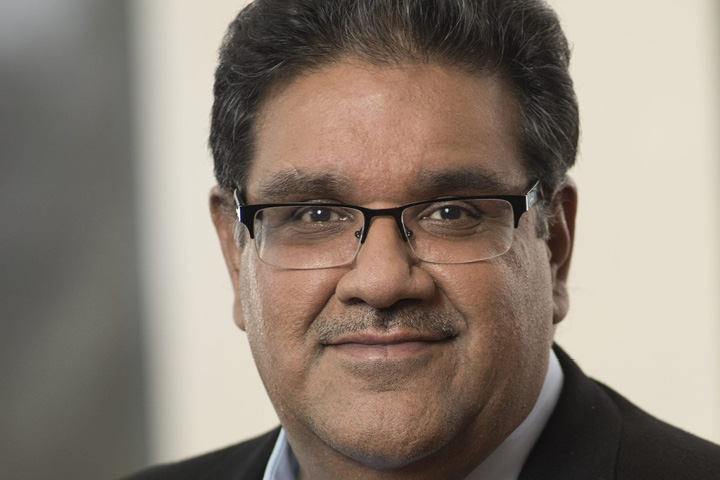Murthy Renduchintala
Dr Venkata Murthy Renduchintala (best known as ‘Murthy’) is one of the most high-profile alumni of the University of Bradford, having pursued a distinguished career in some of the most well-known companies in the world. Murthy was born in Hyderabad, India. He moved to England when he was three, where he completed his BEng in Electrical Engineering, PhD degree in Digital Communication and Master’s degree in Business Administration in University of Bradford in 1987, 1990 and 1991 respectively, while concurrently worked as a full-time employee at Philips Electronics (1983-2000). He described himself as someone who is fundamentally Indian by upbringing and values, but has had the privilege to work at a global stage. He spent a decade with Philips Electronics until Aug 2000, where he progressed from Research Engineer to Vice President of Engineering for its Consumer Communication Business. Then he served as Vice President and General Manager of Skyworks Solutions Incorporations’ Cellular Systems Division.

Murthy Renduchintala, Technology Executive, Public Company Board Member and UoB Alumni
In Apr 2004, Renduchintala joined Qualcomm as Vice President and by the time he left Qualcomm in 2015 for Intel, he was Executive Vice President of Qualcomm Technologies, and Co-President of Qualcomm CDMA Technologies, responsible for the oversight of all activities related to Qualcomm's semiconductor business within the mobile and computing segment.
In November 2015, Renduchintala joined Intel as President of Client & Internet of Things (IoT) Businesses & Systems Architecture Group at Intel Corporation. He has been Chief Engineering Officer since April 2017 and Group President (Client Computing Group) at Intel Corporation since May 3, 2017.
He has been a member of the Board of Directors and Audit Committee of Accenture Plc since 2018. In November 2015, Murthy was poached by Intel, one of the Silicon Valley’s most iconic companies, from Qualcomm, putting him in charge of the Intel’s PC and IoT business with a mandate to transform Intel and making him the company’s second most powerful executive behind the then CEO Brian Krzanich. By the time he retired in 2020, he was President and Chief Engineering Officer of Technology, Systems Architecture and Client Engineering Group at Intel, bringing his extensive expertise in system-on-chip, mobile and IoT areas and a wealth of experience to the company.
More importantly he brought his calibre and leadership skills to align product design, engineering and business direction to tighten Intel’s strategy and speed execution across the communications, device and IoT segments – all these are core to growth in the smart and connected computing era.
Murthy Prior to joining Intel, Murthy was with Qualcomm CDMA Technologies (QCT) between 2004-2015, first as Vice President of Engineering then rose to Executive Vice President and Co-President of QCT. In 2000, he left Philips Electronics and took up the post of Vice President and General Manager of the Cellular Systems Division in Skyworks solutions (2000-2004).
Murthy is another example of a member of the University alumni who has gone on to make their mark in society, and his success in this industry has provided our students and graduates with an inspiring role model in their industry and an industry that aligns to the interest of the Faculty of Engineering and Informatics.
Given Murthy’s wealth of professional and technical experience, his role as an Honorary Professor includes, but not limited to the following:
- Expert Specialist and Advisor to the Innovation and Skills Advisory Board (ISAB) of the Bradford-Renduchintala Space AI Centre
- Advisor to the Faculty of Engineering and Informatics
- Advisor to the University
Why did I join the Innovation and skills advisory board?
One could argue that the research of space is as long lived as the history of mankind. Afterall, Astronomy is the oldest science and from the dawn of time we have starred up into the stars and wondered what lies out there. Fundamentally, space research allows us to investigate, model and predict important phenomena on a planet-wide scale. Some phenomena are imperceptible or difficult to model at a more local or proximate scale and it is only till you enter the realms of space that they become discernible and modellable.
What really excites me about the ISAB and space research in the future is the possibility of making even more spectacular and life-changing discoveries as we bring together so many fast-moving areas of technology into the realm of space - not just communications technologies but super-scale distributed computing, artificial intelligence, quantum computing, biomedical science – the list is endless. The coordination, superposition, and integration of these massive areas of research into the study of space will take lead to transformative things we cannot even imagine today! To date, we have only witnessed the trailer to the “Space Movie” – the main event awaits us.
What can I offer to the Centre?
Energy, Enthusiasm, Engagement, Experience, Expectations.

